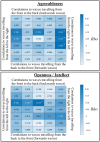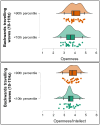Cortical travelling waves relate to variation in personality traits
- PMID: 40851912
- PMCID: PMC12368610
- DOI: 10.1162/IMAG.a.119
Cortical travelling waves relate to variation in personality traits
Abstract
Personality traits must relate to stable neural processes, yet few robust neural correlates of personality have been discovered. Recent methodological advances enable measurement of cortical travelling waves, which likely underpin information flow between brain regions. Here, we explore whether cortical travelling waves relate to personality traits from the "Big Five" taxonomy. We assessed personality traits and recorded resting electroencephalography (EEG) from 300 participants. We computed travelling wave strength using a 3D fast Fourier transform and explored relationships between alpha travelling waves and personality traits. Trait Agreeableness and Openness/Intellect had significant relationships to travelling waves that passed multiple-comparison controls (p FDR = 0.019 and p FDR = 0.036 respectively). Agreeableness related to interhemispheric waves travelling from the right hemisphere along central lines (rho = 0.263, p < 0.001, BF10 = 356.350). This relationship was unique to the compassion aspect (t = 3.719, p < 0.001) rather than politeness aspect of Agreeableness (t = 0.897, p = 0.370). Openness/Intellect related to backwards travelling waves along midline electrodes (rho = 0.197, p < 0.001, BF10 = 13.800), which was confirmed for the Openness aspect (rho = 0.216, p < 0.001, BF10 = 26.444) but not the Intellect aspect (rho = 0.093, p = 0.109, BF10 = 0.344). Greater cortical travelling wave strength from right temporal regions was associated with higher trait compassion, and backwards travelling wave strength along midline electrodes was associated with trait openness. Further research is needed to investigate the mechanistic role of travelling waves in personality traits and other individual differences.
Keywords: compassion; cortical travelling waves; electroencephalography; openness; personality traits.
© 2025 The Authors. Published under a Creative Commons Attribution 4.0 International (CC BY 4.0) license.
Conflict of interest statement
The authors declare that they have no conflicts of interest.
Figures






Similar articles
-
Weak and unstable prediction of personality from the structural connectome.Imaging Neurosci (Camb). 2025 Jan 3;3:imag_a_00416. doi: 10.1162/imag_a_00416. eCollection 2025. Imaging Neurosci (Camb). 2025. PMID: 40800995 Free PMC article.
-
Current Status and Influencing Factors of Chinese Nurses' Compassion Competence: A Cross-Sectional Study.Int J Nurs Pract. 2025 Jun;31(3):e70031. doi: 10.1111/ijn.70031. Int J Nurs Pract. 2025. PMID: 40515442
-
Short-Term Memory Impairment.2024 Jun 8. In: StatPearls [Internet]. Treasure Island (FL): StatPearls Publishing; 2025 Jan–. 2024 Jun 8. In: StatPearls [Internet]. Treasure Island (FL): StatPearls Publishing; 2025 Jan–. PMID: 31424720 Free Books & Documents.
-
Cost-effectiveness of using prognostic information to select women with breast cancer for adjuvant systemic therapy.Health Technol Assess. 2006 Sep;10(34):iii-iv, ix-xi, 1-204. doi: 10.3310/hta10340. Health Technol Assess. 2006. PMID: 16959170
-
Management of faecal incontinence and constipation in adults with central neurological diseases.Cochrane Database Syst Rev. 2014 Jan 13;2014(1):CD002115. doi: 10.1002/14651858.CD002115.pub5. Cochrane Database Syst Rev. 2014. Update in: Cochrane Database Syst Rev. 2024 Oct 29;10:CD002115. doi: 10.1002/14651858.CD002115.pub6. PMID: 24420006 Free PMC article. Updated.
References
-
- Adelstein, J. S., Shehzad, Z., Mennes, M., DeYoung, C. G., Zuo, X.-N., Kelly, C., Margulies, D. S., Bloomfield, A., Gray, J. R., & Castellanos, F. X. (2011). Personality is reflected in the brain’s intrinsic functional architecture. PLoS One, 6(11), e27633. 10.1371/journal.pone.0027633 - DOI - PMC - PubMed
LinkOut - more resources
Full Text Sources
